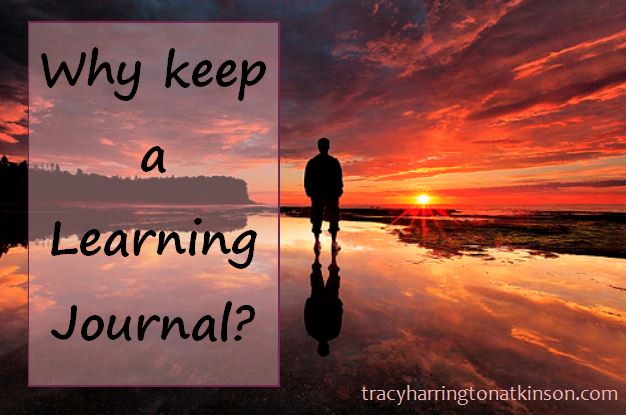The noblest pleasure is the joy of understanding.
~Leonardo Da Vinci
So, why keep a learning journal? Obviously, the greatest answer to this question will be a personal one. Why do it? For me, I do it because it helps me to recall information and to make connections between old and new information. Other reasons:
- To keep a record of what you are learning to recall upon at a later date.
- To notate what you may still need to learn.
- To record learning or professional goals.
- To write down your feelings, trepidation and excitements about a learning experience.
- To chart personal learning preferences.
- To discover a solution.
I noted several years ago a time when I felt particularly frustrated. I felt stagnate as if I had not learned anything or progressed. I sat in front of my shelves and pulled open an old learning journal from my undergraduate degree. What a wonderful experience! I read for a long time as if time stood still. When I rose from the floor, I immediately felt inspired. I felt better. I knew I had grown, learned and changed. I made a renewed commitment to continue with my learning journals and even opted to separate a few into more specialized areas.
What do Researchers Say?
Both educators and learners should be urged to keep an accurate learning journal. Through this autobiographical means, the individual will understand their past learning experiences and how they relate to current learning and teaching incidents. By using this tool, students and educators can understand their personal learning style and how it may be manifested in the classroom. As each learning experience is recorded, they should be used to engage in a reflection period to discuss and ponder on what was learned as well as the method. The results of developing a learning journal and reflecting on these experiences lead to enhanced self-esteem, an evaluative competence of self, acquiring learning principles, accepting responsibility, gaining social forms of learning and being prepared for lifelong learning. (Arikan, 2011; Dam, 2011).
It is essential for educators to investigate their personal learning experiences to understand themselves not only as learners but as instructors. Osterman & Kottkamp (2004) emphasize the importance for educators to understand their learning experiences to enhance their ability to recognize their reactions to their students. Through this means, patterns can be observed and developed or altered as needed. Additionally, it is advantageous for educators to notate their feelings and emotions in learning experiences which only develops the ability to identify particular practices within their profession. The greatest benefit to the learning journal is the development of sensitivity and responsiveness instructors feel as they make connections with their students as they both succeed and struggle during the learning process.
The process of learning from one’s past experiences and current learning as well as teaching experiences needs to be continued through the use of the learning journal. This record will continue to allow for the facilitation of the learning process and individual reflection. However, the recording process does not need to be time consuming. One teacher simply jotted notes of personal remembrance in the margins of her lessons plans, allowing her to revisit them at a later day. Another simple method is through bullet journaling where a record is created through quick bullet points. Despite how a learning journal is kept, the methodology of self-reflection is an opportunity with little risk to the participant (Brookfield, 1995).
Only as both the strengths and weaknesses of these experiences are carefully recorded and reflected upon do educators have the ability to address the strengths and weaknesses of themselves and their students. Armed with this knowledge, they are able to compensate and adjust accordingly (Brown, 2012). They are able to completely understand how their students feel and experience when approaching a new learning opportunity and recognize any gaps between reality and the desired outcome while addressing the fissure before facing a catastrophe (Brookfield, 1995).
By Tracy Atkinson
 Tracy Atkinson, mother of six, lives in the Midwest with her husband and spirited long-haired miniature dachshunds. She is a teacher, having taught elementary school to higher education, holding degrees in elementary education and a master’s in higher education. Her passion is researching, studying and investigating the attributes related to self-directed learners and learning styles. She speaks at conferences on learning styles and has published several titles, including MBTI Learning Styles: A Practical Approach, The Art of Learning Journals, Calais: The Annals of the Hidden, Lemosa: The Annals of the Hidden, Book Two, Rachel’s 8, The Personal Pursuit of Perfection and Securing Your Tent. She is currently working on a non-fiction text exploring the attributes of self-directed learners: The Five Characteristics of Self-directed Learners. Check out her online courses at: Udemy.
Tracy Atkinson, mother of six, lives in the Midwest with her husband and spirited long-haired miniature dachshunds. She is a teacher, having taught elementary school to higher education, holding degrees in elementary education and a master’s in higher education. Her passion is researching, studying and investigating the attributes related to self-directed learners and learning styles. She speaks at conferences on learning styles and has published several titles, including MBTI Learning Styles: A Practical Approach, The Art of Learning Journals, Calais: The Annals of the Hidden, Lemosa: The Annals of the Hidden, Book Two, Rachel’s 8, The Personal Pursuit of Perfection and Securing Your Tent. She is currently working on a non-fiction text exploring the attributes of self-directed learners: The Five Characteristics of Self-directed Learners. Check out her online courses at: Udemy.


Comments are closed